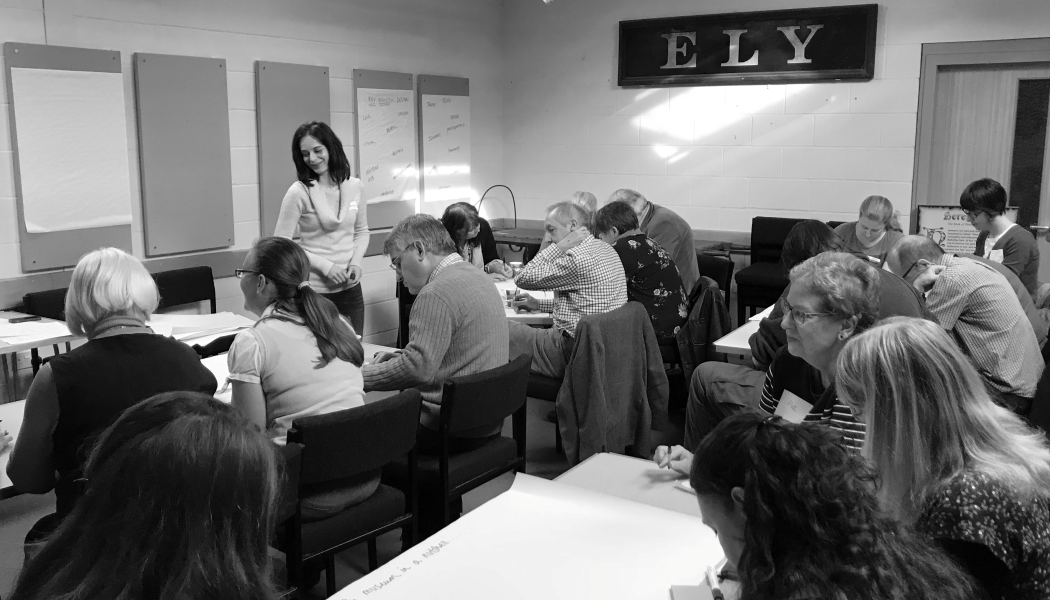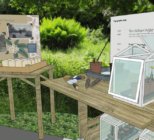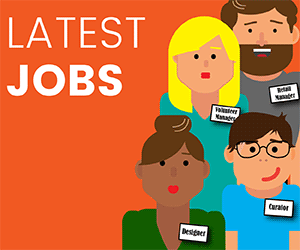Evaluation is not only the cornerstone of all successful projects, it should also play a crucial role in your developing, managing and delivering your organisation’s strategic vision.
This short blog will look at an evaluation tool that crops up quite often now called the Theory of Change. Theory of Change models have been around since about the early 2000s, and have been used well, and not so well, ever since.
For many the Theory of Change sounds like the jargon we mentioned above, but in actual fact, take away the high-falutin’ title, and what you are actually doing is simply ‘telling the story of how your activities are making an impact and how you are proving the impact is real’.
Theory of Change or TOC for short, is an evaluation tool that builds measuring impact into the heart of our client’s projects; where we can measure the ACTUAL good brought by a client’s activities, not just recording the numbers. As Evaluation consultants AND planners, TOC is a joy to behold (once you get your head around it!)
Once we began looking into the Theory of Change, we realised this provided us with the framework we had been looking for. Not only this, but the structure worked well with our own approaches to measuring social value (in line with the recommendations by Social Value UK) and Inspiring Learning For All (Inspiring Learning For All)
So what is Theory of Change?
Theory of Change is a planning process created specifically for planning and measuring impact. It is not a general theory of how change happens; rather, the theory is specific to your effort.
Theory of Change is useful for setting goals, strategic planning, and programme evaluation.
For us and our clients, we like to work it backwards from:
Vision > Audiences > Outcomes > Indicators > Outputs >Interventions > Inputs > Benchmarks
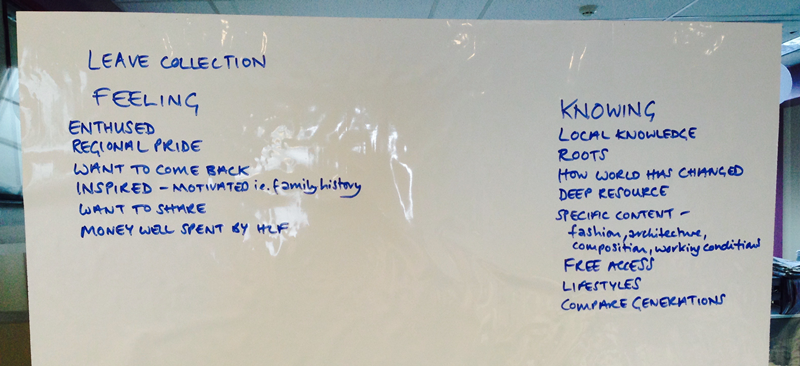
It sets out the vision and gives people a planning framework to say:
‘Okay, I want to be at Point B in five years’ time. I’m currently here at Point A, but in order to get to Point B, a number of things have to change for certain people.
‘Okay, so if certain things have to change, how will I know they are changing and I’m on the right track? What evidence might I be looking for?’
‘Right, now I’ve got a list of evidence I think would tell me that things are changing, what would I have to do / what activities need to take place to produce those bits of evidence…’
So you see, it really is planning – something we do every single day in our professional lives – but done backwards, looking where we want to be and developing at story of how we are going to get there and how we plan to use the evidence to tell us whether we’re on the right track or not.
Part 1 – Planning your Theory of Change
A Theory of Change cannot develop in a vacuum. It needs to be informed by your vision of the future, and through its use, it will re-inform that strategic vision both for your project and organisation.
Part 1 of developing a Theory of Change requires you to have considered the following:
- Determine the vision – What is the overall aim?
- Define who the target audiences are – you might have considered your audiences strategically above, but each target audiences may need specific interventions. Make sure you are clear who the target audience is when creating your TOC
- Outline the outcomes for change you want your project to have – these are the actual differences your project will make to its participants and society.
- Prioritise – Which outcome(s) will your project focus on?
- What are your indicators – what will you look at to see if your project is making a difference?
- What are your data collection methods? How will you measure your indicators?
Outcome and Indicators:
Our Glossary of Terms blog has more information on the meaning of outcomes and indicators if you need a bit more help.
Broadly, an outcome is the effect of your activities, measured through evidenced progress along agreed benchmarks, has over time. What change do you specifically want to see for each audience? Try using adjectives like … more, less, fewer… e.g. more women empowered to access educational courses.
Indicators are usually our old friends Key Performance Indicators (KPIs) or Outcomes Indicators. These are the specific and measurable data or information you can gather that tell whether you’re on the right track and your activities are actually delivering a change. By deciding what you want to collect, you will be able to determine how you want to collect it and what’s best for different audiences.
Layout
There is no set format for laying out a Theory of Change. We recommend they are highly visual, using images, graphics or charts, whatever works best for you!
Don’t worry about making them look ‘logical’ – the important thing here is communicating your message clearly.
Part 2 – Logic Models
As outlined above, the Theory of Change covers the strategic elements of evaluation planning – the Whys, Whats and some of the detailed Whos (audience segments) of your project.
These will help you think from the top-down about what changes you want your project to have.
However, in order to be successful, the project actually has to have activities.
Whether a capital build, community engagement project, or recruiting more volunteers, you need to begin to think about the Hows in order to achieve the desired changes. That’s where the Logic Model steps in.
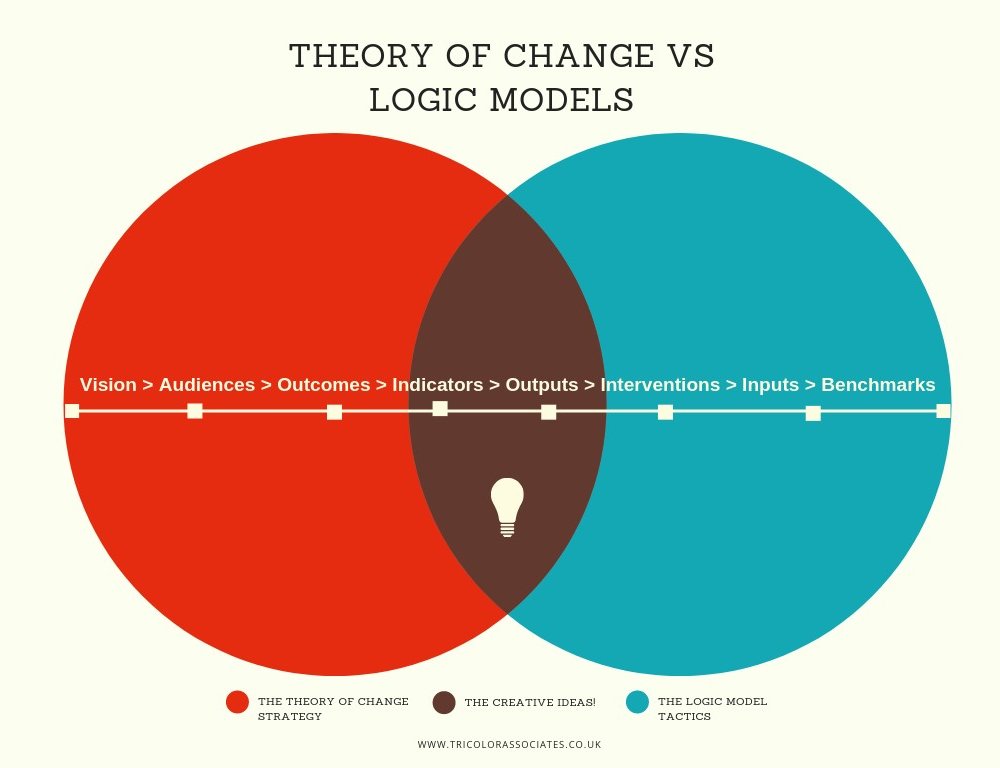
Unlike its creative sister, a Logic model is more structured, linear, and is a useful tool to help plan and deliver specific interventions as part of the project.
The stages of developing a logic model are:
- Determine the interventions (tasks, participation, activities and to be used to achieve identified outcomes)
- Define your inputs – Decide what will be done, by who, how, and when. What resource is required for these interventions?
- Testing the ideas – how will they work?
- What assumptions are in place? What are you assuming will, or will not happen? Are you assuming an audience will participate? Is there evidence to back up that assumption, or do you need to do more research?
- What external factors could affect the success of the project?
- How will you establish reliable benchmarking data?
Layout
There is no prescribed layout for a Logic Model, but at Tricolor, we tend to use a structure similar to that suggested by The National Lottery Heritage Fund.

You can do a master Logic Model for your overall interventions, or, you can do specific models for each. Whatever structure works well for you, make sure you have spent enough time considering these elements before starting the interventions themselves.
Benchmarking
This process can feel a little long at the very start of the project, when all you really want to do is get planning your activities and get people engaged. But as the old saying goes “if you fail to prepare, prepare to fail”
YOU CAN’T EFFECTIVELY EVALUATE OUTCOMES AFTER THE FACT. Afterall, if you don’t know where you started, how will you know when you’ve arrived?
Funders and donors have supported you not for what you do, but for what you achieve, and if you cannot tell an evidenced story that it is YOUR ACTIVITIES that led to a SPECIFIC SET OF CHANGES, then you may struggle to convince people of the validity of your work.
Before launching into an activity, gather enough research so you can comfortably create a benchmark. Ideally, this would be with the participants themselves, through a starting survey or an observation, a focus group, or a multitude of different evaluation mechanisms. Whilst you may not be able to engage all participants for benchmarking right at the start, make sure you look for external, reliable data can you draw on to create a benchmark or assumption baseline.
Without a starting place, it is extremely difficult to measure the impact your project has had on audiences. Without the original context, you cannot know whether it was your project that encouraged your activity participant to access higher learning courses or the WI group she attends on a Wednesday.
Failing to benchmark can lead to inaccurate reporting and unreliable data.
Theory of Change vs Logic Models
The two sister structures need one another in order to be successful. Traditional evaluation planning has looked solely at the ‘Hows’ – intervention, input, audiences, benchmarks, monitoring. It just records what happens, rather than why.
Every intervention that forms part of your project needs to have a reason. Funders will not support interventions for the sake of intervention – you need to prove that your project will have an impact, and then outline what you will do to achieve it, not the other way around.
However, without the logic of the logic model, a theory of change is just that, a theory. It doesn’t detail how the change will be measured, or provide a structure for gathering that data on a micro-level. It doesn’t help you plan the activity, it just tells you there will be one.
Evaluation
Now to evaluate our series so far, we’d love to hear what you’d like to learn about next in the series on Evaluation. Tweet us @TricolorHeritag or on Insta @TricolorHeritage or on Facebook @TricolorAssociates.
Don’t like to be social? Email us on [email protected] and you can get a free and bespoke evaluation and funding webinar with one of our consultancy team. Just mention #M&HEvaluate
